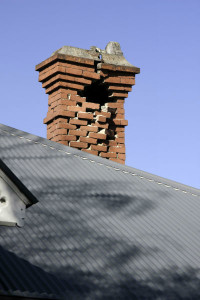Each spring, we see the obvious effects of winter weather. Cracked sidewalks and large potholes demonstrate what happens when the moisture from rain, sleet and snow combines with freezing cold temperatures. What you might not realize is that winter has the same effect on chimneys as it does on other porous masonry materials.
Your chimney and the freeze-thaw cycle
Your chimney’s masonry is extremely porous and soaks in any water that comes in contact with it. When the temperature drops, that water freezes and expands. The effect is crumbing mortar, spalling bricks and cracked chimney crowns. If water is making its way down your chimney’s flue, the moisture can cause cracked or crumbling flue tiles, as well. That damage can compromise the structural integrity of your chimney, and it can inhibit your chimney’s ability to protect your home from the heat and flames of your fireplace.
Repairing your chimney’s winter damage
Because winter is so hard on your chimney, it’s important either to give it a quick visual inspection each spring or schedule your annual inspection. Look for signs of freeze-thaw damage in your chimney’s masonry and on your chimney crown. If you notice signs of freeze-thaw damage in any part of your chimney, the experts at Environmental Chimney Service can help you get your chimney repaired! A spring chimney inspection gives you the time to have your chimney repaired before you’re ready to use it again. It’s important not to let freeze-thaw damage go unrepaired, as unrepaired minor damage can quickly become costly major damage.
Preventing freeze-thaw damage
Environmental Chimney Service also can help you take steps to protect your chimney from moisture and the freeze-thaw cycle. First, having a chimney cap securely installed helps to keep water from running down your flue and causing damage inside your chimney or inside your fireplace. A properly constructed chimney crown helps to divert water away from the outer walls of your chimney. The best way to keep moisture from damaging your chimney through the freeze-thaw cycle is with waterproofing. Waterproofing involves applying a solution to your chimney. That solution keeps nearly 100 percent of water from seeping into your chimney’s masonry while still allowing your chimney’s masonry to “breathe” and exhaust gas from your fireplace. If water can’t penetrate your chimney’s masonry, that means the freeze-thaw cycle can’t damage your chimney!
Call Environmental Chimney Sweep to schedule an appointment to help keep freeze-thaw damage at bay. We can inspect your chimney for signs of freeze-thaw damage, recommend and perform any necessary repairs or help you take action to prevent the freeze-thaw cycle from damaging your chimney. Winter’s freeze-thaw cycle can be brutal, but with Environmental Chimney Service, you don’t have to let that cycle compromise the strength and integrity of your chimney!

